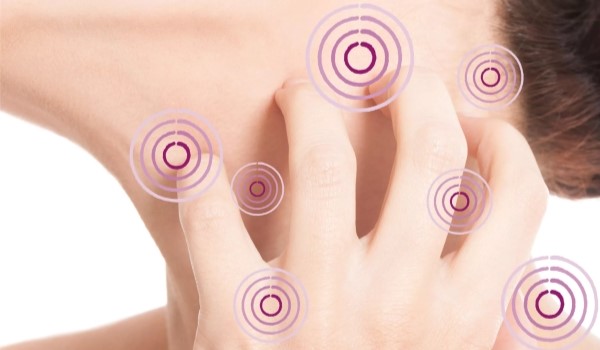What exactly is
Urticaria?
Urticaria (also known as hives or nettle rash) is a common skin condition characterized by the sudden appearance of itchy, raised wheals on the skin. These skin lesions are similar to those caused by stinging nettles, which gives the disease its colloquial name.
Hives are a common skin condition that can affect people of all ages and genders. In most cases it is acute and subsides on its own within a few hours or days. However, there are also chronic forms of hives in which the skin reaction lasts longer than six weeks and therefore severely impairs the quality of life of those affected.
About the symptoms
More information
Important facts about urticaria
Symptoms and consequences of hives:
- Itchy, raised wheals on the skin (reddened skin with clearly defined bumps)
- The wheals can have different sizes and sometimes merge into larger areas
- The skin lesions are often pale in the center and reddish at the edges
- The skin reactions can spread over the entire body and often occur in episodes
- Possibly accompanied by swelling of the face, lips or around the eyes (angioedema)
- Intense itching can lead to scratching, which can further irritate the skin and cause injury
Similar looking diseases?
Dermatitis herpetiformis Duhring: Special form of coeliac disease and is triggered by a hypersensitivity reaction to the protein gluten. It is characterized by severe itching and small, grouped, red, raised papules and blisters that often appear in symmetrical patterns on the elbows, knees, neck, shoulders or buttocks.
Insect bites: Bites or stings from insects such as mosquitoes, fleas or bedbugs can cause itchy, raised skin lesions that resemble wheals. This reaction is often referred to as "insect bite-related urticaria", although technically it is not urticaria in the classic sense.
Drug exanthema: Drug exanthema is an allergic reaction to certain medications. Itchy, red skin changes may occur, which may look like urticaria hives. However, this skin reaction is usually more extensive and often affects larger areas of the skin.
Causes and forms of urticaria
Spontaneous urticaria (acute and chronic urticaria)
Around two thirds of people who suffer from urticaria have so-called spontaneous urticaria, where no specific triggers for the skin disease can be identified. Generally, triggers such as allergens and infections are associated with this form. In the acute form, the symptoms occur spontaneously and usually last less than 6 weeks. Chronic urticaria, on the other hand, lasts longer than 6 weeks and can last for months or even years. Some cases of chronic urticaria are associated with an autoimmune reaction in which the immune system produces antibodies against the body's own tissue, leading to skin reactions.
Physical urticaria (inducible urticaria)
In these forms, certain physical stimuli can be assigned as triggers for the skin reactions. Cold urticaria, for example, is a reaction to cold, while pressure urticaria is caused by pressure on the skin. Solar urticaria is triggered by sunlight, vibrational urticaria by vibration. In contrast to spontaneous urticaria, in physical urticaria the skin changes only occur in the areas that are exposed to the specific stimulus. Examples of this are
Other forms of hives
Other forms include specific types of hives that are provoked by exertion (stress-induced urticaria), contact with water (aquagenic urticaria) or sweating (cholinergic urticaria). In aquagenic urticaria, for example, even small amounts of water (warm or cold) trigger the skin reactions.
Around two thirds of people who suffer from urticaria have so-called spontaneous urticaria, where no specific triggers for the skin disease can be identified. Generally, triggers such as allergens and infections are associated with this form. In the acute form, the symptoms occur spontaneously and usually last less than 6 weeks. Chronic urticaria, on the other hand, lasts longer than 6 weeks and can last for months or even years. Some cases of chronic urticaria are associated with an autoimmune reaction in which the immune system produces antibodies against the body's own tissue, leading to skin reactions.
In these forms, certain physical stimuli can be assigned as triggers for the skin reactions. Cold urticaria, for example, is a reaction to cold, while pressure urticaria is caused by pressure on the skin. Solar urticaria is triggered by sunlight, vibrational urticaria by vibration. In contrast to spontaneous urticaria, in physical urticaria the skin changes only occur in the areas that are exposed to the specific stimulus. Examples of this are
Other forms include specific types of hives that are provoked by exertion (stress-induced urticaria), contact with water (aquagenic urticaria) or sweating (cholinergic urticaria). In aquagenic urticaria, for example, even small amounts of water (warm or cold) trigger the skin reactions.
How is urticaria diagnosed?
The diagnosis of hives (urticaria) requires a careful medical history, a thorough physical examination and sometimes special tests to identify the specific form of the disease. If hives are suspected, a doctor, preferably a dermatologist or an allergist, should be consulted. Accurate diagnosis of hives is crucial to initiate appropriate treatment and identify possible triggers to prevent future flare-ups.
Sources
Please note that all content provided regarding individual medical conditions, treatments, procedures, etc. is general information and may vary depending on the physician:in and individual case and initial situation.
For more detailed information, please always consult your doctor.
DynaMed (Internet), Ipswich (MA). Acute urticaria. EBSCO Information Services. Record No. T916900. 2018 (1995).
DynaMed (Internet), Ipswich (MA). Chronic urticaria. EBSCO Information Services. Record No. T115276. 2018 (1995).
Charité University Hospital Berlin: What is urticaria?
www.allergie-centrum-charite.deEuropean Centre for Allergy Research Foundation: Urticaria
www.ecarf.orgAltmeyer, P.: Urticaria (overview) (February 15, 2021)
www.altmeyers.org